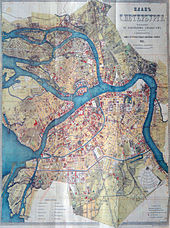They have canals..............bridges...........etc...........in St. Pete........Russia......just like here in Dc................i wonder if there are any real people there...................b/c there ain't here..........
In 1725, Peter died at the age of fifty-two. His endeavours to modernize Russia had met with opposition from the Russian nobility—resulting in several attempts on his life and a treason case involving his son.[21] In 1728, Peter II of Russia moved his seat back to Moscow. But four years later, in 1732, under Empress Anna of Russia, Saint Petersburg was again designated as the capital of the Russian Empire. It remained the seat of the Romanov dynasty and the Imperial Court of the Russian Tsars, as well as the seat of the Russian government, for another 186 years until the communist revolution of 1917.
In 1736–1737 the city suffered from catastrophic fires. To rebuild the damaged boroughs, a committee under Burkhard Christoph von Münnich commissioned a new plan in 1737. The city was divided into five boroughs, and the city center was moved to the Admiralty borough, situated on the east bank between the Neva and Fontanka.
It developed along three radial streets, which meet at the Admiralty building and are now one street known as Nevsky Prospekt (which is considered the main street of the city),Gorokhovaya Street and Voznesensky Prospekt. Baroque architecture became dominant in the city during the first sixty years, culminating in the Elizabethan Baroque, represented most notably by Bartolomeo Rastrelli with such buildings as the Winter Palace. In the 1760s, Baroque architecture was succeeded by neoclassical architecture.
Established in 1762, the Commission of Stone Buildings of Moscow and Saint Petersburg ruled that no structure in the city can be higher than the Winter Palace and prohibited spacing between buildings. During the reign of Catherine the Great in the 1760s–1780s, the banks of the Neva were lined with granite embankments.
However, it was not until 1850 that the first permanent bridge across the Neva, Blagoveshchensky Bridge, was allowed to open. Before that, only pontoon bridges were allowed. Obvodny Canal (dug in 1769–1833) became the southern limit of the city.
The most prominent neoclassical and Empire-style architects in Saint Petersburg included:


Comments
Post a Comment